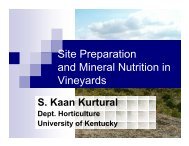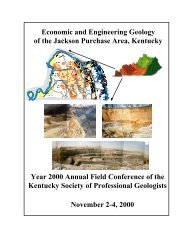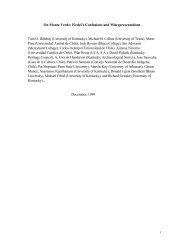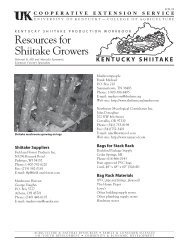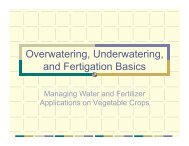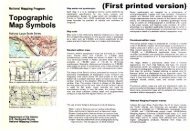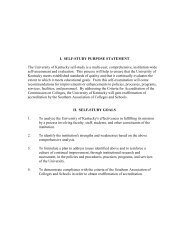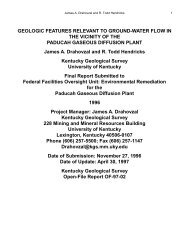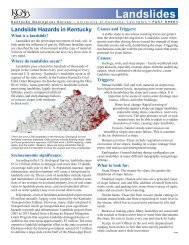Ground Motion for the Maximum Credible Earthquake in Kentucky ...
Ground Motion for the Maximum Credible Earthquake in Kentucky ...
Ground Motion for the Maximum Credible Earthquake in Kentucky ...
Create successful ePaper yourself
Turn your PDF publications into a flip-book with our unique Google optimized e-Paper software.
2<br />
<strong>Ground</strong>-<strong>Motion</strong> Hazard Maps<br />
Table 1. Relationship between perceived shak<strong>in</strong>g, potential damage, MMI and PGA.<br />
Perceived<br />
Shak<strong>in</strong>g not felt weak light moderate strong<br />
very<br />
strong severe violent extreme<br />
Potential<br />
Damage none none none very light light moderate<br />
moderate/<br />
heavy heavy<br />
very<br />
heavy<br />
PGA (%g) < 0.17 0.17–1.4 1.4–3.9 3.9–9.2 9.2–18 18–34 34–65 65–124 > 124<br />
MMI I II–III IV V VI VII VIII IX X+<br />
studied seismic zone <strong>in</strong> <strong>the</strong> central United States.<br />
The estimated moment magnitude <strong>for</strong> <strong>the</strong> largest<br />
event of <strong>the</strong> New Madrid series ranges from 7 to<br />
8—a large range. <strong>Earthquake</strong>s are also <strong>in</strong>frequent<br />
<strong>in</strong> <strong>the</strong> central United States, especially large ones<br />
that have significant impact on humans and <strong>the</strong><br />
built environment. Recurrence <strong>in</strong>terval estimates<br />
<strong>for</strong> large earthquakes range from about 500 to 1,000<br />
years <strong>in</strong> <strong>the</strong> New Madrid Seismic Zone to about<br />
2,000 to 5,000 years <strong>in</strong> <strong>the</strong> Wabash Valley Seismic<br />
Zone; <strong>the</strong>y are even longer <strong>in</strong> o<strong>the</strong>r zones. Several<br />
ground-motion attenuation relationships are available<br />
<strong>for</strong> <strong>the</strong> central United States, but all are based<br />
on numerical model<strong>in</strong>g and sparse strong-motion<br />
records from small earthquakes.<br />
Although earthquakes cannot be prevented<br />
and are difficult to predict, disasters caused by<br />
<strong>the</strong>m can be mitigated. Mitigation is <strong>the</strong> most effective<br />
and viable approach to deal<strong>in</strong>g with seismic<br />
hazards. Seismic hazard assessment is <strong>the</strong> basis <strong>for</strong><br />
development, adaptation, and implementation of<br />
mitigation policies and measures. Seismic hazard<br />
maps, depict<strong>in</strong>g a level of ground motion with an<br />
associated recurrence <strong>in</strong>terval <strong>in</strong> a region, are developed<br />
from a seismic hazard assessment.<br />
<strong>Ground</strong>-<strong>Motion</strong> Hazard Maps<br />
Different k<strong>in</strong>ds of seismic hazard maps are<br />
be<strong>in</strong>g produced from seismic hazard assessments.<br />
Probabilistic seismic hazard analysis (PSHA) and<br />
determ<strong>in</strong>istic seismic hazard analysis (DSHA) are<br />
<strong>the</strong> most commonly used methods of assessment.<br />
PSHA and DSHA use <strong>the</strong> same seismological <strong>in</strong>put<br />
parameters, but def<strong>in</strong>e and calculate seismic<br />
hazard fundamentally differently. In PSHA, seismic<br />
hazard is def<strong>in</strong>ed as <strong>the</strong> ground motion with<br />
an annual probability of be<strong>in</strong>g exceeded (i.e., probability<br />
of exceedance <strong>in</strong> one year) and calculated<br />
from a triple <strong>in</strong>tegration (i.e., a pure ma<strong>the</strong>matical<br />
model<strong>in</strong>g). PSHA was developed from <strong>the</strong><br />
approximation of an earthquake as a s<strong>in</strong>gle po<strong>in</strong>t<br />
source (i.e., a po<strong>in</strong>t-source model <strong>for</strong> earthquakes)<br />
(Cornell, 1968; McGuire, 2004). In modern seismology,<br />
however, an earthquake is considered a<br />
f<strong>in</strong>ite fault, not a s<strong>in</strong>gle po<strong>in</strong>t; this is particularly<br />
true <strong>for</strong> large earthquakes, which are of safety concern.<br />
The ma<strong>the</strong>matical <strong>for</strong>mulation of PSHA has<br />
been found to be <strong>in</strong>correct (Wang and Zhou, 2007;<br />
Wang, 2009). There<strong>for</strong>e, PSHA is not consistent<br />
with modern earthquake science (Wang and Zhou,<br />
2007; Wang, 2009), and results from PSHA are difficult<br />
to understand and use. For example, PSHA<br />
has been used to develop national seismic hazard<br />
maps (Frankel and o<strong>the</strong>rs, 1996, 2002; Petersen and<br />
o<strong>the</strong>rs, 2008). Use of <strong>the</strong> national hazard maps <strong>in</strong><br />
<strong>the</strong> central United States has caused problems <strong>in</strong><br />
many communities, such as Memphis, Tenn. (Ste<strong>in</strong><br />
and o<strong>the</strong>rs, 2003), and Paducah, Ky. (Wang, 2003,<br />
2005). As a result, <strong>the</strong> 2008 national seismic hazard<br />
maps have not been recommended <strong>for</strong> use <strong>in</strong> <strong>the</strong><br />
new edition of <strong>the</strong> “NEHRP Recommended Provisions<br />
<strong>for</strong> Seismic Regulations <strong>for</strong> New Build<strong>in</strong>gs<br />
and O<strong>the</strong>r Structures,” published by <strong>the</strong> Build<strong>in</strong>g<br />
Seismic Safety Council (Kircher and o<strong>the</strong>rs, 2008). 1<br />
The U.S. Geological Survey (2009) also cautioned<br />
that “<strong>the</strong> 2008 national seismic hazard maps should<br />
not be substituted <strong>for</strong> <strong>the</strong> model build<strong>in</strong>g code design<br />
maps nor should <strong>the</strong>y be used with ASCE/SEI<br />
41 or 31 <strong>for</strong> seismic rehabilitation or evaluation.” 2<br />
In DSHA, seismic hazard is def<strong>in</strong>ed as <strong>the</strong><br />
maximum ground motion from a s<strong>in</strong>gle earthquake<br />
or set of earthquakes, and is calculated directly<br />
from statistics on earthquakes and ground motion.<br />
Although DSHA is not <strong>the</strong> preferred method, it has<br />
1<br />
NEHRP stands <strong>for</strong> <strong>the</strong> National <strong>Earthquake</strong> Hazards Reduction Program, authorized by <strong>the</strong> U.S. Congress.<br />
2<br />
AESC/SEI 31 and 41 are standards <strong>for</strong> seismic rehabilitation of exist<strong>in</strong>g build<strong>in</strong>gs, put toge<strong>the</strong>r by <strong>the</strong> American<br />
Society of Civil Eng<strong>in</strong>eers’ Structural Eng<strong>in</strong>eer<strong>in</strong>g Institute.



